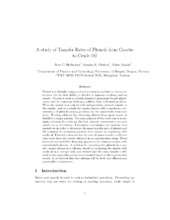| dc.contributor.author | Hoffmann, Alex Christian | |
| dc.contributor.author | Pletten, Sandra Stang | |
| dc.contributor.author | Mania, Mirko | |
| dc.date.accessioned | 2020-03-13T13:18:11Z | |
| dc.date.available | 2020-03-13T13:18:11Z | |
| dc.date.issued | 2019-04 | |
| dc.Published | Hoffmann AC, Pletten, Mania. A study of transfer rates of phenols from caustic to crude oil. Separation and Purification Technology. 2019;212:515-519 | eng |
| dc.identifier.issn | 1873-3794 | en_US |
| dc.identifier.issn | 1383-5866 | en_US |
| dc.identifier.uri | https://hdl.handle.net/1956/21491 | |
| dc.description.abstract | Phenol and phenolic compounds are a common problem in various industries, due to their ability to dissolve in aqueous solutions, such as caustic. Caustic is used in several industrial operations for pH adjustments and for removing hydrogen sulfides from raffinated products. When the caustic is in contact with such products, phenols transfer to the caustic, and as a result the caustic leaves with a significant concentration of phenols causing problems in the waste-water treatment plant. Finding solutions for extracting phenols from spent caustic is therefore a major priority. The main purpose of this work was to investigate solutions for reducing the high phenols concentration in spent caustic at an oil refinery. Laboratory experiments and analysis were carried out in order to determine the mass-transfer rate of phenols and the potential for extracting phenols from caustic by contacting with crude oil. Plausible estimates for the over-all mass-transfer coefficient were made from the results obtained in an experimental setup. These estimates are useful for designing apparatus for treating streams with concentrated phenols. A solution for extracting the phenols in a specific caustic stream in a refinery, based on contacting the caustic with crude oil in a storage tank, was devised and the mass transfer coefficient in this particular system was estimated based on the experimental results. It is believed that this solution will be both cost efficient and practicable to implement. | en_US |
| dc.language.iso | eng | eng |
| dc.publisher | Elsevier | en_US |
| dc.rights | Attribution CC BY-NC-ND | eng |
| dc.rights.uri | http://creativecommons.org/licenses/by-nc-nd/4.0/ | eng |
| dc.title | A study of transfer rates of phenols from caustic to crude oil | en_US |
| dc.type | Peer reviewed | |
| dc.type | Journal article | |
| dc.date.updated | 2020-01-22T16:50:20Z | |
| dc.description.version | acceptedVersion | en_US |
| dc.rights.holder | Copyright 2019 Elsevier | en_US |
| dc.identifier.doi | https://doi.org/10.1016/j.seppur.2018.11.058 | |
| dc.identifier.cristin | 1689255 | |
| dc.source.journal | Separation and Purification Technology | |
| dc.source.pagenumber | 515-519 | |
| dc.identifier.citation | Separation and Purification Technology. 2019;212:515-519 | |
| dc.source.volume | 212 | |

